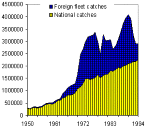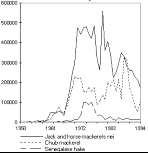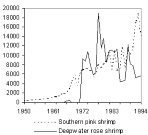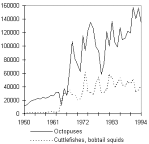FAO Fisheries Circular No. 920 FIRM/C920
Rome, 1997
ISSN 0429-9329
REVIEW OF THE STATE OF WORLD FISHERY RESOURCES: MARINE FISHERIES
by
Marine Resources Service,
Fishery Resources Division,
Fisheries Department,
FAO, Rome, Italy
4. EASTERN CENTRAL ATLANTIC
FAO Statistical Area 34
INTRODUCTION
 The Eastern Central Atlantic, off the West coast of Africa, from the
Gibraltar Strait to the mouth of the Zaire river (Figure
B4.1) and encompasses temperate, tropical, and equatorial waters, lagoons
and mangroves as well as oceanographic features such as major currents, upwellings,
and equatorial convergence. About 190 species or groups of species were caught
in the area during the 1950-1994 period by a total of 22 area States and 25
distant-water fishing nations.
The Eastern Central Atlantic, off the West coast of Africa, from the
Gibraltar Strait to the mouth of the Zaire river (Figure
B4.1) and encompasses temperate, tropical, and equatorial waters, lagoons
and mangroves as well as oceanographic features such as major currents, upwellings,
and equatorial convergence. About 190 species or groups of species were caught
in the area during the 1950-1994 period by a total of 22 area States and 25
distant-water fishing nations.
The fisheries in the region are characterized by the dominance of small pelagics, especially sardine and other clupeids that account for nearly 50% of total catches. In the late 1980s, changes in Eastern Europe first resulted in the appearance of a number of new distant-water fishing nations. Lately, changes in economies in these countries and the increased emphasis placed on market forces have resulted in a reduction of catches in Area 34, especially of small pelagic fishes.
PROFILE OF CATCHES
Figure B4.2
 After the record figure of about 4.1 million tonnes in 1990, total reported
catch for Area 34 have reduced to 2.9 million tonnes in 1994 (Figure
B4.2 and Table IV). Apart from above-average
landings between 1988 and 1991, annual totals varied between 2.5 million tonnes
and 3.3 million tonnes throughout the 1970s and 1980s. These variations are
mainly to be attributed to fluctuations in small pelagic resources such as
horse mackerel and sardine, largely influenced by climatic changes as well
as changing fishing pressure from Eastern Europe countries.
After the record figure of about 4.1 million tonnes in 1990, total reported
catch for Area 34 have reduced to 2.9 million tonnes in 1994 (Figure
B4.2 and Table IV). Apart from above-average
landings between 1988 and 1991, annual totals varied between 2.5 million tonnes
and 3.3 million tonnes throughout the 1970s and 1980s. These variations are
mainly to be attributed to fluctuations in small pelagic resources such as
horse mackerel and sardine, largely influenced by climatic changes as well
as changing fishing pressure from Eastern Europe countries.
Figure B4.3
 In 1994, 22 coastal states recorded 78% of the area production. The steady
development of their national fisheries results in an average 20% increase
per year since 1950 (Figure B4.3). Long-range
fishing fleets of 25 foreign countries mainly catching small pelagic fish
account for 22% of the catch in 1994. This proportion is markedly reduced
compared to earlier levels which exceeded 50% in 1971-77.
In 1994, 22 coastal states recorded 78% of the area production. The steady
development of their national fisheries results in an average 20% increase
per year since 1950 (Figure B4.3). Long-range
fishing fleets of 25 foreign countries mainly catching small pelagic fish
account for 22% of the catch in 1994. This proportion is markedly reduced
compared to earlier levels which exceeded 50% in 1971-77.
Figure B4.5
 The majority of ISSCAAP Group 34 (jacks, mullets, sauries, etc.) catches come
from horse mackerel (included in jack and horse mackerels nei, Figure
B4.5). Catches of these species increased sharply in the late 1960s, remained
high through most of the 1970s but declined through most of the 1980s and
1990s. The other main finfish ISSCAAP Groups are 37 (mackerels, snoeks, cutlassfishes,
etc.) and 32 (cods, hakes, haddocks, etc.). Catches of chub mackerel dominate
Group 37, with two exceptional years in 1988-89, followed by a collapse in
1993 and slight recovery in 1994, while the Senegalese hake has been the major
contributor to Group 32, with huge catches in the 1970s and relatively steady
but much lower catches since. European hake catches are stable between 10
000 t and 13 000 t since 1986.
The majority of ISSCAAP Group 34 (jacks, mullets, sauries, etc.) catches come
from horse mackerel (included in jack and horse mackerels nei, Figure
B4.5). Catches of these species increased sharply in the late 1960s, remained
high through most of the 1970s but declined through most of the 1980s and
1990s. The other main finfish ISSCAAP Groups are 37 (mackerels, snoeks, cutlassfishes,
etc.) and 32 (cods, hakes, haddocks, etc.). Catches of chub mackerel dominate
Group 37, with two exceptional years in 1988-89, followed by a collapse in
1993 and slight recovery in 1994, while the Senegalese hake has been the major
contributor to Group 32, with huge catches in the 1970s and relatively steady
but much lower catches since. European hake catches are stable between 10
000 t and 13 000 t since 1986.
| Figure B4.7 | Figure B4.8 |

 Catches of ISSCAAP Group 45 (shrimp, prawns, etc.) represent 1.4% of the total
catches (Figure B4.7). Southern pink shrimp catches
started to become significant in 1966 and have since regularly increased with
a sharp peak, reaching 19 000 t in 1993 before declining to 14 000 t in 1994.
The deepwater rose shrimp fishery started from nothing in 1971 and catches have
shown a great variability, with a very high value of 19 000 t in 1978 but only
about 5 000 t in 1986-88 and 1992-94.
Catches of ISSCAAP Group 45 (shrimp, prawns, etc.) represent 1.4% of the total
catches (Figure B4.7). Southern pink shrimp catches
started to become significant in 1966 and have since regularly increased with
a sharp peak, reaching 19 000 t in 1993 before declining to 14 000 t in 1994.
The deepwater rose shrimp fishery started from nothing in 1971 and catches have
shown a great variability, with a very high value of 19 000 t in 1978 but only
about 5 000 t in 1986-88 and 1992-94.
Catches of ISSCAAP Group 57, (squid, cuttlefish, octopus, etc.) (Figure B4.7) represent 6.9% of 1994 total catches. The octopus fishery started off in 1966 and has since kept an upward trend, though with large variations, to reach 135 000 t in 1994 (Figure B4.8). Catches of cuttlefish have been relatively constant around the value of 40 000 t.
RESOURCES STATUS AND MANAGEMENT
This review of the status of stocks is based on assessments undertaken by recent ad hoc Working Groups on the evaluation of the major fisheries resources in the region and conclusions of the Working Party on Resources Evaluation of the Fishery Commission for the Eastern Central Atlantic (CECAF), Accra, Ghana (10th Session, 10-13 October 1994) and the Fishery Committee for the Eastern Central Atlantic (CECAF), Dakar, Senegal, 18-20 December 1995. Quantitative estimates of potential catches for many stocks were obtained during CECAF ad hoc Working Groups.
Northern Areas
Total catches of demersal stocks on the Mauritania continental shelf have decreased from 36 000 t (1984) to 12 800 t (1992), which could reflect a change in fishing strategy (e.g. replacement of target species, increase of discarded fishes, incomplete statistics, etc.). Hakes have been considered moderately exploited while other demersal fish species are more intensively exploited. Quantitative evaluation of many demersal resources has not been undertaken due to the unavailability of required data. Demersal resources off Senegal are considered slightly over-exploited. The Maximum Sustainable Yield (MSY) for these resources is estimated to be around 130 000 t (1994). Coastal demersal resources off The Gambia are fully or over-exploited with MSY estimated at 15 000 t (1993).
Two stocks of common octopus are caught by the Northwest African cephalopod fisheries. The northern one, off the Saharan coast, is believed able to support a potential MSY catch of 75 000 t. The southern one off Cape Blanc, is considered fully or overexploited, with an estimated MSY of 50 000 t. Catches from the southern stock in 1992 (a total of 44 000 t landed in Mauritania) have returned to the high levels observed in 1986-87. This recovery is not due to fisheries management, but rather to a drop in catch rates resulting in a 40% reduction in fishing activity of the trawler fleet and a decrease in the proportion of juveniles in the catches during 1987-92. Exploitation patterns have improved as a result of use of selective gears by the artisanal fishery. The level of exploitation of other species of cephalopods, such as squids and cuttlefish, is lower than that of octopus: their catches account for 15% of the cephalopods landed. Landings of octopus and associated by-catch species from the Northwest African cephalopod fisheries have shifted during recent years from Las Palmas to other ports in Northwest Africa. Management measures taken in Morocco include a two month closed season and a reduction of foreign vessels operating in the area.
The MSY of the central sardine stock of Morocco was estimated to be some 550 000 t and the present level of exploitation is considered moderate. The large stocks of small pelagics in this region - sardine, mackerel and horse mackerel - are highly variable, and their assessment difficult. Acoustic surveys carried out off Northwest Africa in 1992 showed that the school density of small pelagics (mainly sardinella, sardine excluded) was very high, particularly off Mauritania, with biomass estimated at about 4 million tonnes. In addition, the biomass of mackerel and horse mackerel in the area between Morocco and the Bissagos Islands was estimated to be 830 000 t.
The potential MSY catch of total small pelagic species (other than sardine) in the zone from Sahara to Senegal was estimated at 1 200 000 t. Until 1992, the different species groups of sardinella, horse mackerels and mackerels were moderately exploited. The level of exploitation of coastal pelagic resources has reduced with the decrease of fishing activities of Eastern Europe fleets. The profitability of different options for fishing, processing and marketing of catches should be studied at national level with a view to finding the best options for taking catches formerly harvested by foreign fleets.
In Mauritania area, pink spiny lobster stocks continue to be heavily exploited. Northern and southern stocks of green lobsters are probably over-exploited. A clam stock (Venus rosalina) with a potential of about 300 000 t had been discovered off the coast of Mauritania and is still unexploited for commercial reasons. Stocks of deep-sea crab (Chaceon maritae) seem to be reasonably exploited. The present level of catch of deep-sea shrimp (Parapenaeopsis atlantica) is around 1 200 to 2 400 t, and the state of stocks seems to allow a possible controlled increase of shrimp fishing activities.
In Cape Verde waters the most important resources are tunas. Spiny lobsters are now fully exploited and a freeze in fishing effort has been recommended. Updated potential catches of demersal fish are not available, and it is possible that marine fisheries resources in Cape Verde are not fully exploited.
Southern Areas
The continental shelves of Guinea Bissau, Guinea and Sierra Leone are characterized by coastal fish assemblages (croakers) principally located in nutrient-rich estuarine and inshore areas. Trigger fish that appeared in large quantities in the seventies have now completely disappeared. The exploitation rate applied to cuttlefish stocks has been increasing since 1984 and by 1990 was considered to be equal to, or slightly above, the optimal fishing effort. The rate of growth of these organisms appears faster than previously estimated.
In Guinea, current estimates based on recent trawl surveys indicate a total biomass of demersal resources to be around 180 000 t, of which 44 000 t are of high or medium commercial value. Assessments made by CECAF in 1991 were updated in 1994 (Working Group held at the Centre national des sciences halieutiques de Boussoura, Conakry, Guinea) and show that total demersal biomass decreased by around 50% between 1991 and 1994. The decrease in biomass of the main demersal species, such as croakers, threadfins and sicklefish, was higher than 50 percent. It was suggested that this change in biomass was related to the recent increase of small-scale artisanal and industrial fishing effort. Interactions with the more commercial large-scale fisheries has led to major problems for the traditional artisanal fishery. Fishery production of the coastal area up to 20m depth was estimated at about 40 000 t per year.
Trawl surveys carried out on the Guinea continental shelf have shown that between 1985 and 1990 the estimated biomass of coastal resources in waters less than 20 m deep (roughly up to 15 nm offshore) declined from 112 000 to 49 000 t during the rainy season and from 72 000 to 48 000 t during the dry season. This reduction between 1985 and 1990 can be explained by the increase in fishing activity of trawlers in inshore areas.
In Sierra Leone, small pelagic species are exploited by the artisanal fishery only. Their current level of catches ranges between 22 000 and 30 000 t. Acoustic surveys have estimated biomass to be between 70 000 and 120 000 t, suggesting that controlled development of the industrial sub-sector may be possible. Current annual landings for demersal stocks by trawlers ranged from 8 000 to 20 000 t between 1991 and 1993. Reduced catch rates are currently observed in the fishery and the level of exploitation of demersal fish stock is considered high. MSY has been estimated to lie between 46 500 t and 65 000 t.
Current annual production of Southern pink shrimp in Sierra Leone was found to fall within the MSY estimate of 2 600 to 3 500 t. Reduced catch rates are currently observed in the fishery, and the level of exploitation of shrimp is considered high. In the west and central Gulf of Guinea, potential catches of shrimps were estimated at 4 700 t, and stocks were considered over-exploited. Demersal resources are fully exploited with biomass estimates ranging between 64 000 and 104 000 t.
Marine resources of the Gulf of Guinea are mainly exploited by Côte d'Ivoire, Ghana, Togo, Benin, Nigeria, Cameroon and Equatorial Guinea, among others. Multi-species fisheries are common in the Gulf of Guinea. Small pelagic resources are exploited by small-scale gillnets and semi-industrial purse-seine in Côte d'Ivoire, Ghana, Togo and Benin and exclusively by small-scale fisheries in Nigeria and Cameroon. Coastal demersal resources are composed of sciaenids (exploited by small-scale and semi-industrial fisheries in Nigeria, Benin, Togo and Cameroon), groupers and snappers (fished in Togo and Ghana with hooks-and-lines in untrawlable areas), and sparids (Côte d'Ivoire and Ghana). The white shrimp resources off Nigeria and Cameroon are fished exclusively by artisanal fishery while pink shrimp is exploited by trawlers of the semi-industrial fishery. Penaeid shrimps in Togo and Benin and in Côte d'Ivoire are caught in lagoon fisheries. The offshore demersal resources of Ghana and Côte d'Ivoire are made up of sparids along with the slope community, while the offshore demersal resources of Nigeria and Cameroon are primarily drift fish and redfishes.
The recent biomass estimates of 7 000 t in Congo and 31 000 t in Gabon for stocks of Sciaenidae and Sparidae were based on acoustic surveys carried out in 1994. Demersal resources were either close to, or fully exploited. Effort reduction and redistribution would be beneficial, as fishing concentrates in the inshore zone and on juveniles. Small pelagic species (sardinellas, mackerels and anchovies) are important but unstable resources in the Western Gulf of Guinea (Côte d'Ivoire-Ghana-Togo-Benin) and their stocks are shared. Sardinella stocks seem to be in good shape. Substantial recruitment of S. aurita has been observed in Ghana and Benin in 1988 and 1989. The fishing pattern in recent years has been different from that of 1985 and 1987, with regard to the availability of the resources. Potential catches of small pelagics in the west and central Gulf of Guinea have been estimated at 330 000 t and are fully exploited. Little is known about pelagic and demersal resources in the whole southern Gulf of Guinea. Many countries have not developed an appropriate database and research structures to analyze stock exploitation status.
Acoustic surveys in the northern shelf of Angola indicated during 1985-1989 a decline in the biomass of small pelagics (sardinella and horse mackerel). The trend has dramatically reversed during the 1990s and the current biomass level now exceeds 500 000 t. Horse mackerel (T. trecae) biomass was estimated at about 250 000 t (1994). High biomass values for both round sardinella and Madeira sardinella were also recorded in the South Gabon - Congo region, 135 000 t in 1994. Horse mackerel biomass was estimated at 25 000 t. These estimates indicate a considerable increase in biomass compared to previous survey results, confirming the trends observed in Angola. Small pelagic stocks are considered under-exploited.
Environmental changes manifesting a periodic variability in coastal upwelling intensities are playing a role in coastal pelagic fish abundance fluctuations.